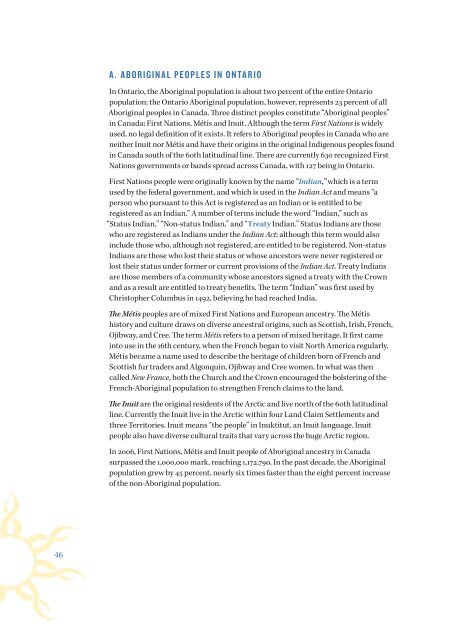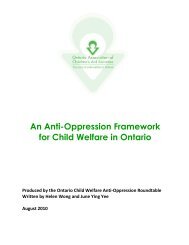English - Ontario Association of Children's Aid Societies
English - Ontario Association of Children's Aid Societies
English - Ontario Association of Children's Aid Societies
Create successful ePaper yourself
Turn your PDF publications into a flip-book with our unique Google optimized e-Paper software.
A. ABORIGINAL PEOPLES IN ONTARIO<br />
In <strong>Ontario</strong>, the Aboriginal population is about two percent <strong>of</strong> the entire <strong>Ontario</strong><br />
population; the <strong>Ontario</strong> Aboriginal population, however, represents 23 percent <strong>of</strong> all<br />
Aboriginal peoples in Canada. Three distinct peoples constitute “Aboriginal peoples”<br />
in Canada: First Nations, Métis and Inuit. Although the term First Nations is widely<br />
used, no legal definition <strong>of</strong> it exists. It refers to Aboriginal peoples in Canada who are<br />
neither Inuit nor Métis and have their origins in the original Indigenous peoples found<br />
in Canada south <strong>of</strong> the 60th latitudinal line. There are currently 630 recognized First<br />
Nations governments or bands spread across Canada, with 127 being in <strong>Ontario</strong>.<br />
First Nations people were originally known by the name “Indian,” which is a term<br />
used by the federal government, and which is used in the Indian Act and means “a<br />
person who pursuant to this Act is registered as an Indian or is entitled to be<br />
registered as an Indian.” A number <strong>of</strong> terms include the word “Indian,” such as<br />
“Status Indian,” “Non-status Indian,” and “Treaty Indian.” Status Indians are those<br />
who are registered as Indians under the Indian Act; although this term would also<br />
include those who, although not registered, are entitled to be registered. Non-status<br />
Indians are those who lost their status or whose ancestors were never registered or<br />
lost their status under former or current provisions <strong>of</strong> the Indian Act. Treaty Indians<br />
are those members <strong>of</strong> a community whose ancestors signed a treaty with the Crown<br />
and as a result are entitled to treaty benefits. The term “Indian” was first used by<br />
Christopher Columbus in 1492, believing he had reached India.<br />
The Métis peoples are <strong>of</strong> mixed First Nations and European ancestry. The Métis<br />
history and culture draws on diverse ancestral origins, such as Scottish, Irish, French,<br />
Ojibway, and Cree. The term Métis refers to a person <strong>of</strong> mixed heritage. It first came<br />
into use in the 16th century, when the French began to visit North America regularly.<br />
Métis became a name used to describe the heritage <strong>of</strong> children born <strong>of</strong> French and<br />
Scottish fur traders and Algonquin, Ojibway and Cree women. In what was then<br />
called New France, both the Church and the Crown encouraged the bolstering <strong>of</strong> the<br />
French-Aboriginal population to strengthen French claims to the land.<br />
The Inuit are the original residents <strong>of</strong> the Arctic and live north <strong>of</strong> the 60th latitudinal<br />
line. Currently the Inuit live in the Arctic within four Land Claim Settlements and<br />
three Territories. Inuit means “the people” in Inuktitut, an Inuit language. Inuit<br />
people also have diverse cultural traits that vary across the huge Arctic region.<br />
In 2006, First Nations, Métis and Inuit people <strong>of</strong> Aboriginal ancestry in Canada<br />
surpassed the 1,000,000 mark, reaching 1,172,790. In the past decade, the Aboriginal<br />
population grew by 45 percent, nearly six times faster than the eight percent increase<br />
<strong>of</strong> the non-Aboriginal population.<br />
46

















